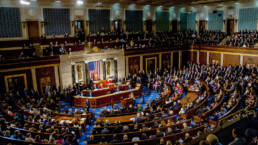The cost of new stimulus checks would leave the DoD’s spending levels about where they were a year before Trump took office.
by Stephen Semler, Responsible Statecraft
The conference version of the 2023 National Defense Authorization Act that passed the House last week demonstrates that the United States has two distinct policy responses to inflation: one for the Pentagon, and one for the public.
Any real or imagined drop in the Pentagon’s buying power is met with more money. Inflation informed President Joe Biden’s requested $31 billion boost from fiscal year 2022 to 2023, and the issue is Congress’s primary justification for upping that proposed increase to $76 billion. If enacted into law, the NDAA will spike military spending to $858 billion in fiscal year 2023 — excluding supplemental funding for Ukraine military aid — putting even peak Cold War-era Pentagon budgets to shame.

The public gets a much different treatment. In inflationary times, Biden and most of Congress think that the Pentagon should get more money and the public should get less. Pandemic relief programs were ended in an ill-fated attempt to curb rising costs. Now nearly two-thirds of Americans are living paycheck to paycheck. For most workers, real wages have failed to keep up with inflation over the past year. While Biden endorsed the NDAA’s historic topline figure, he hasn’t proposed any legislation that would lend the public a hand during a spiraling cost-of-living crisis.
In other words, only for the Pentagon is federal spending considered a solution to inflation. Non-military spending, meanwhile, is routinely blamed for causing inflation, despite there being far more relevant culprits like corporate greed, the war in Ukraine, Western sanctions on Russia, and the seismic disruptions to the global supply chain caused by the pandemic.
Recent Posts
‘Unconstitutional. Unethical. Authoritarian.’ ICE Bars Millions Of Immigrants From Bond Hearings
July 18, 2025
Take Action Now One watchdog said the new policy “seems like a blatant attempt to stop them from exercising their right to due process.”……
Americans Are Not Nearly Alarmed Enough About Climate Change
July 18, 2025
Take Action Now Americans still don’t comprehend how imminent, dangerous, and far-reaching the threat is—and journalists are partly to blame.By…
The IRS Is Building A Vast System To Share Millions Of Taxpayers’ Data With ICE
July 17, 2025
Take Action Now ProPublica has obtained the blueprint for the Trump administration’s unprecedented plan to turn over IRS records to Homeland Security…
Israel’s Sudden Assault On Syria Is Unchecked Aggression
July 17, 2025
Take Action Now Jerusalem is bombing Damascus and threatening al-Sharaa’s rule, while Washington was hoping to help the nascent government on…




